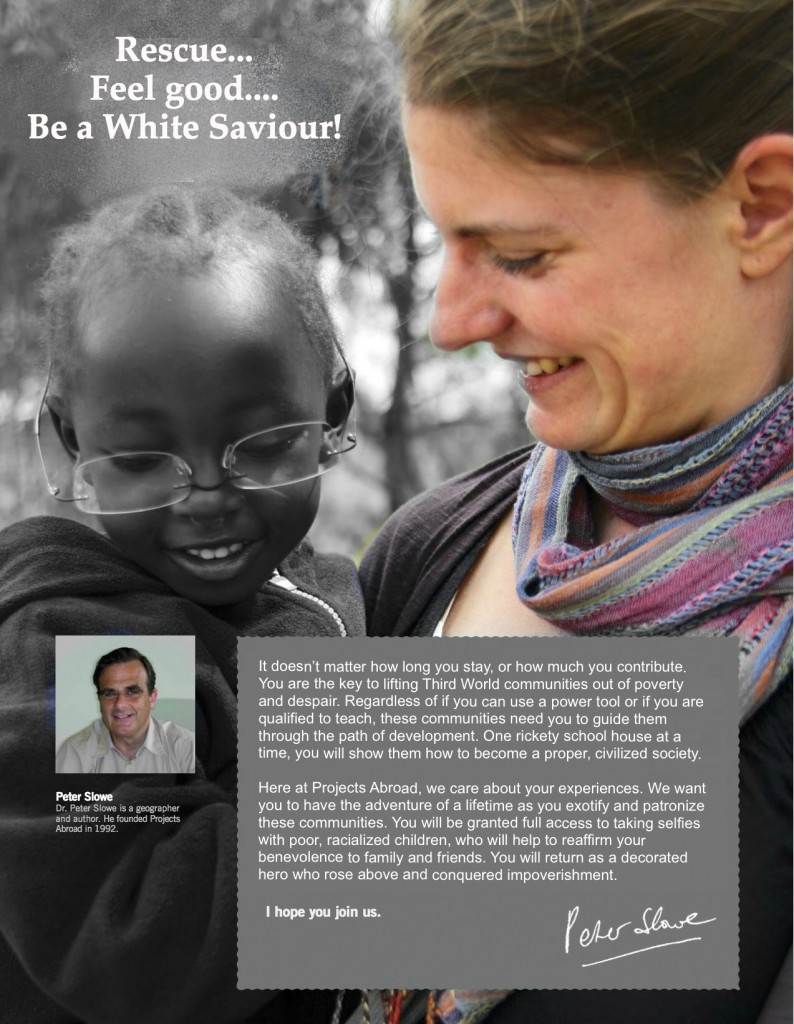Original Advertisement:

If this image can’t be viewed on your screen, please view this blog post outside of the UBC Connect server, or see the attached files.
Analysis of original advertisement
One of the most problematic aspects of this ad is its reproduction of the white saviour complex. White saviourism is a patronizing practice/belief whereby white/privileged people enter less privileged, racialized communities in the developing world to do beneficial work and make a “difference.” This idea is made evident by the line that states, “you will be in demand, and you will be needed,” where “you” refers to white/privileged folks. Yet, this ad neglects the fact that white saviourism can often result in ineffective or potentially detrimental impacts to the communities receiving aid. It also perpetuates the idea that racialized, less developed communities are helpless, disempowered, and in need of saving by those from the Global North. White saviourism assumes that the problems of developing communities can be easily “fixed,” without paying attention to the diverse and complex realities they experience. This ad reproduces misguided assumptions about the benefits of international aid, and serves to satiate white/privileged egos.
In addition, the composition of the ad situates the white saviour as the subject, and places the racialized, less privileged community as the object. This is evident in the way in which the child is held by the woman to make her appear kind and affectionate. It is also apparent in the manner in which international volunteering is articulated. This ad emphasizes the benefits of international aid to its white, privileged subjects, such as how the experience is “worthwhile, adventurous and enjoyable.” Here, international volunteering is portrayed to be a transformative process for the individual providing aid, whereas as the community receiving aid is less important and placed in the background. According to this ad, the ability of these volunteers to learn more about the developing world is more valuable than the impacts of international aid to the communities themselves. As such, this ad maintains the Othering of racialized, less privileged communities.
Jammed Advertisement:

If this image can’t be viewed on your screen, please view this blog post outside of the UBC Connect server, or see the attached files.
Explanation of Jamming Philosophy
I chose to alter the colours of this ad to explicitly highlight the difference between who is the subject and who is the object. By changing the colour of the child to grey scale, I hoped to draw attention to how communities that receive international aid often serve as the background to white/privileged subjects. The position of white/privileged individuals as subjects is indicated by how they are still represented in full colour.
I changed the phrase “help…learn…explore!” to “Rescue…Feel Good…Be a White Saviour!” in order to illuminate the problematic ideologies that sustain humanitarian work in developing communities (i.e., white saviourism). The use of sarcasm enabled me to critique taken for granted assumptions of the benefits of international aid. For example, the first paragraph in the grey box explicitly states some of the reasons behind why people engage in humanitarian work. While these aims may seem exaggerated, it draws attention to how these assumptions play a major role in justifying white saviour approaches to humanitarian work. By undermining these exaggerated claims with mockery (e.g., by saying “One rickety school house at a time…”), I wanted to highlight the disjuncture between theoretical beliefs of white saviourism, and the actual outcomes behind such work. I also decided to refer to developing communities as the “Third World” to sarcastically illustrate how white saviour narratives often fails to recognize the complexities of these communities.
The second paragraph puts forth a conceited focus on the subject to show how white saviourism celebrates the white/privileged individual over the community that is receiving aid. Similar to the first paragraph, sarcasm is used to critique the implications of white saviourism in developing communities (such as the exotification of other cultures). In doing so, this ad questions the legitimacy of the idea that international volunteers are “in demand” by developing communities. Moreover, by suggesting that humanitarian aid can be driven by personal motives to appear compassionate and generous, I hoped to challenge those who claim to be simply “helping” the less privileged Other. Ultimately, the jammed ad critically examines the dominant ideologies that inform approaches to humanitarian aid, and encourages its audience to (re)consider who benefits from such practices and beliefs.
Source: http://www.projects-abroad.ca/about-us/get-a-brochure/download/
To view the original ad, please click here.
To view the jammed ad, please click here.

